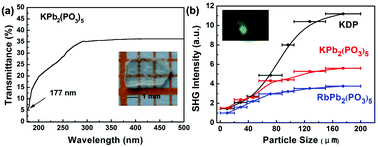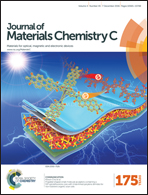KPb2(PO3)5: a novel nonlinear optical lead polyphosphate with a short deep-UV cutoff edge†
Abstract
It is a challenge to explore deep-ultraviolet (DUV) nonlinear optical (NLO) crystals in a Pb-containing system due to the red-shift caused by the Pb atom. Here, three new NLO crystals APb2(PO3)5 (A = K, Rb and Cs) were synthesized. Their single-crystal X-ray diffraction patterns indicate that they are isostructural and crystallize in the asymmetric space group of Pn (No. 7). Interestingly, KPb2(PO3)5 displays moderate powder second harmonic generation (SHG) intensities (0.5× KDP) in type I phase matching behaviors with a short UV cut-off edge of 177 nm, which is the shortest UV cut-off edge among Pb-containing NLO crystals. To better understand the blue-shift of the band gap of KPb2(PO3)5, the theoretical calculations by density functional theory were done. In addition, RbPb2(PO3)5 shows a SHG response of 0.3× KDP and is phase matchable. According to first-principles calculations, compared with RbBa2(PO3)5, KPb2(PO3)5 has a noticeable enhancement in birefringence (0.021 and 0.009 at 1064 nm for KPb2(PO3)5 and RbBa2(PO3)5, respectively). Furthermore, the relationship between its structure and NLO properties was also discussed by calculation of dipole moments.


 Please wait while we load your content...
Please wait while we load your content...